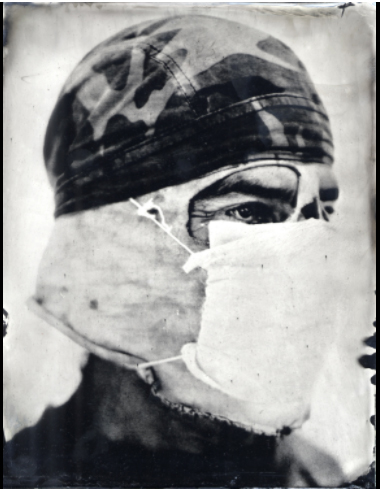May 28, 2014
Ear Worm: Blood Meridian

I've heard about the brutality of Cormac McCarthy's Blood Meridian and tended to shy away from it, fearing gratuitousness in the tell of the tale of war. I decided to take the plunge, wanting the metaphysical jolt that I appreciated from his No Country for Old Men.
After the listen, I started to google a little research. Slate's Noah Gallagher Shannon reveals the evolution from early drafts to finished novel. Just what and when was the Mexican-American War? Was it true that McCarthy was inspired by the diary of Samuel Chamberlain? (Yes, quite a bit.) Just who was the Glanton Gang?
After the war in summer 1849, Glanton and his gang were hired in a nominally mercenary operation by Mexican authorities, to track down and kill dangerous bands of Apache Indians in northern Mexico and what is now part of the Southwest. To earn more money, the Glanton gang began murdering and scalping peaceful agricultural Indians and Mexican citizens alike to claim under the bounty for scalps. The state of Chihuahua put a bounty on the heads of the gang, declaring them outlaws by December 1849.[1] Chihuahua authorities drove the gang out to Sonora where they also wore out their welcome and moved into what is now Arizona....
In Arizona, Glanton's men killed some Quechan natives and took over operating their ferry on the Gila River in Arizona, which transported migrants to the California Gold Rush. They sometimes killed the Mexican and American passengers to take their money and goods.[1] A band of Quechan led by Caballo en Pelo killed and scalped Glanton and most of his gang in retaliation. They reclaimed the tribe's ferry business.[5] The California state government recruited men for a militia and directed the ill-fatedGila Expedition military operation against the Quechan tribe.
***

You can read Life Magazine's 1956 feature, Chamberlain's Mexican War Diary, quite an experience to scroll through the pages and period ads as you read through the piece. (Sam Chamberlain is an "Outsider" Artist!, it's a wonder to see the paintings!)
***
Confronting the horror of colonial aggression. The displacement of American Indians is indeed a stain in our history (everyone sings mea culpas), but stains tend to spread and this history includes all of the Americas. Including Mexico.
I Wikipedia: The Apache-Mexico Wars. I discovered that the first gold rush was for scalps that were paid with coin.In 1835, the government of Sonora put a bounty on the Apache which, over time, evolved into a payment by the government of 100 pesos for each scalp of a male 14 or more years old. Later, Chihuahua offered the same bounty for males plus a bounty of 50 pesos for the capture of an adult female and 25 pesos for a child under 14. Bounty hunters were also allowed to keep any Apache property they captured. The bounty for one Apache male was more than many Mexicans and American workers earned in a full year.
It is unclear, however, whether the scalp bounty was actually paid during the first few years.
So, just when was the time frame and context for what we call the Gold Rush?
The first significant gold rush in the United States was in Cabarrus County, North Carolina (east of Charlotte), in 1799 at today's Reed's Gold Mine.[3] Thirty years later, in 1829, the Georgia Gold Rush in the southern Appalachians occurred. It was followed by the California Gold Rush of 1848-55 in the Sierra Nevada, which captured the popular imagination. The California gold rush led directly to the settlement of California by Americans and the rapid entry of that state into the union in 1850. The gold rush in 1849 stimulated worldwide interest in prospecting for gold, and led to new rushes in Australia, South Africa, Wales and Scotland.
Back to Wikipedia's Mexican-American War:
The Mexican-American War, also known as the Mexican War, the U.S.-Mexican War, the Invasion of Mexico, the U.S. Intervention, or theUnited States War Against Mexico, was an armed conflict between theUnited States and the Centralist Republic of Mexico (which reestablished its 1824 federal constitution during the war, becoming the Second Federal Republic of Mexico) from 1846 to 1848 in the wake of the 1845 U.S.annexation of Texas, which Mexico considered part of its territory despite the 1836 Texas Revolution.
Combat operations lasted a year and a half, from the spring of 1846 to the fall of 1847. American forces quickly occupied New Mexico and California, then invaded parts of Northeastern Mexico and Northwest Mexico; meanwhile, the Pacific Squadron conducted a blockade, and took control of several garrisons on the Pacific coast further south in Baja California. Another American army captured Mexico City, and the war ended in a victory for the United States.
***
(Source for image at top of blogpost, Mexican vigilante)
Posted by Dennis at May 28, 2014 6:59 AM
Leave a comment